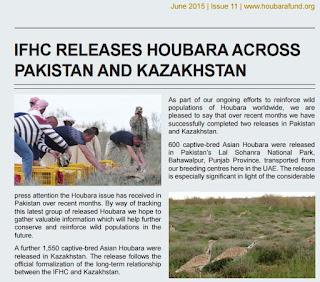Every year in Pakistan, there is a great hue & cry in the media over hunting of the "endangered" Houbara Bustard. These reports are largely based on incomplete understanding of the situation, half truths & poor research on the subject. The reports have recently led to the Supreme Court of Pakistan imposing a complete ban on Houbara hunting and cancelling all permits. In this article, I will highlight aspects of this issue that are largely kept hidden from the public in Pakistan.
To begin with, the IUCN red list of threatened species lists the conservation status of the Asian Houbara Bustard as 'vulnerable' and not 'endangered'. The word endangered repeatedly used in Pakistani media implies a higher level of threat and is misleading.
A second misconception created by the media is that the numbers of Houbara in Pakistan are rapidly declining. Following is a quote from a 2014 WWF Pakistan's report
The Sheikh's of UAE are portrayed as the greatest enemies of the species and blamed for the decline of Houbara population in Pakistan. Hardly ever a mention is made that the same people lead the largest conservation effort of these birds in the world under the banner of International Fund for Houbara Conservation. IFHC runs conservation projects and Houbara captive breeding programmes that, in the last 18 years, have produced 74,475 birds of the Asian species & 131,763 birds of the African Houbara species. In 2014 alone 25,588 Asian Houbara birds were produced in IFHC breeding centres in Abu Dhabi & Kazakhstan. Six hundred birds were recently released in the Lal Sohanra National Park, Bahawalpur. Since Houbaras are a migratory species, birds released in Kazakhstan increase the regional population and these birds find their way to Pakistan in the winter months.
WWF advocates "Controlled hunting of the species to be undertaken within the framework of species conservation." I wish our media would do a little more research before raising false alarms and our judiciary would call in experts before ruling on such issues.
To begin with, the IUCN red list of threatened species lists the conservation status of the Asian Houbara Bustard as 'vulnerable' and not 'endangered'. The word endangered repeatedly used in Pakistani media implies a higher level of threat and is misleading.
A second misconception created by the media is that the numbers of Houbara in Pakistan are rapidly declining. Following is a quote from a 2014 WWF Pakistan's report
the population of Houbara Bustard in Pakistan which was declining rapidly two decades ago has stabilized in the last twenty years since. As an example, conservation efforts started by Houbara Foundation International Pakistan and provincial wildlife department of Balochistan have revealed positive trend in Nag Valley (Rashid, H 2003). WWF-Pakistan appreciates these positive trends
 |
| IFHC Breeding Centre |
WWF advocates "Controlled hunting of the species to be undertaken within the framework of species conservation." I wish our media would do a little more research before raising false alarms and our judiciary would call in experts before ruling on such issues.

No comments:
Post a Comment